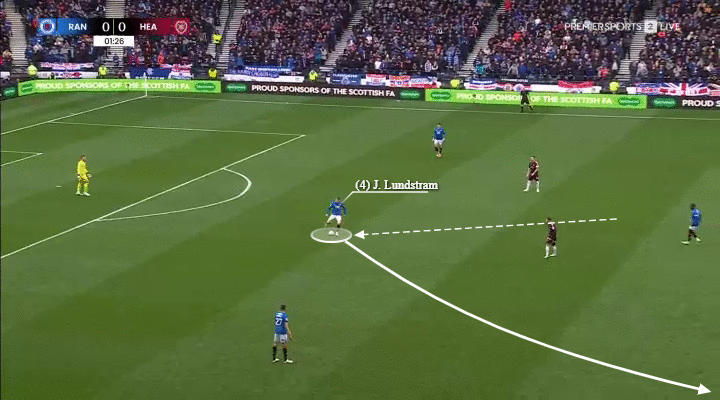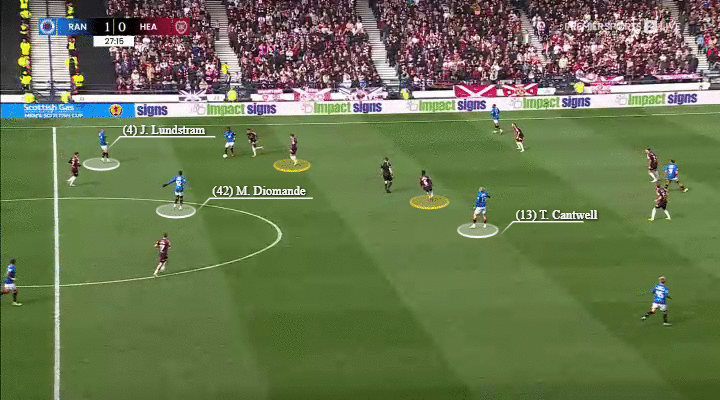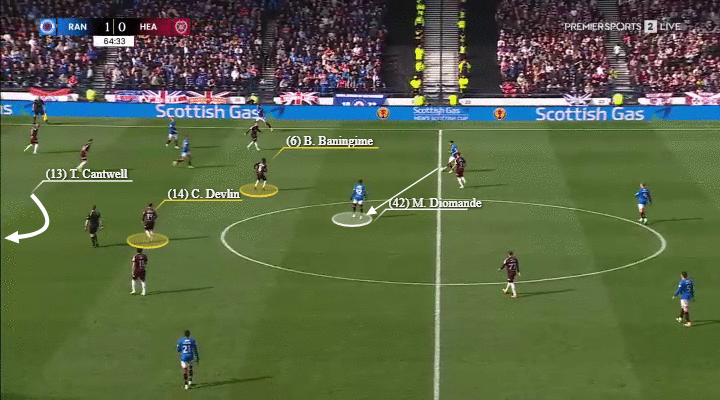
“I wasn’t expecting to have that much space at times. The way we set up, we try to get me on the ball, sometimes it is harder than others,” Todd Cantwell reflected post-match on Sunday, following Rangers’ 2-0 win over Hearts.
“Teams tend to drop off against us and it can be difficult, Hearts came to press us. But we are comfortable playing out with the ball and that showed.”
Rangers’ progression to set up the first Old Firm Scottish Cup Final in 22 years had a lot to do with Cantwell. It was his two moments of quality that were matched by two Cyriel Dessers finishes to split the sides at Hampden. The 26-year-old has been criticised for his big-game showings at points but this was Cantwell at his best - driving his team forward, connecting the attack, taking risks and providing the moments that mattered. And the game’s tactical set-up played right into his hands.
As Cantwell correctly outlines, there was far more space on offer than other domestic encounters Rangers face. On a day when Philippe Clement’s side were in need of a performance, Steven Naismith’s choice to move to a 4-4-2 shape off the ball provided the necessary space.
Hearts wanted to attack spaces behind a vulnerable Rangers defence and their decision to move from a customary back five was likely influenced by that.
However, with the Ibrox side challenged by their manager to beat the press more often, Mohamed Diomande back at the base of midfield and Connor Goldson’s absence leading to a downturn in diagonals, this game was decided by the simple three-vs-two overload that Rangers constantly achieved in midfield. Cantwell was right at the heart of everything his side did well.
READ MORE: The making of Todd Cantwell: Norwich coach on football-mad 'maverick'
In short, Cantwell was always ghosting behind Beni Baningime and Cammy Devlin, who were occupied by John Lundstram and Mohamed Diomande, but ahead of the centre-back duo of Frankie Kent and Kye Rowles - neither of whom are agile defenders that jump into midfield.
Hearts were likely gambling on Rangers struggling to build play, as they have recently. They likely presumed that Lundstram would drop into defence, enabling Baningime and Devlin to match up with Cantwell and Baningime. But the Tynecastle side's press rarely worked and time after time, Rangers managed to play through the middle by finding their attacking midfielder.
Let’s take a look at some examples of how Rangers overloaded the midfield shown in GIF format.
In the second minute, Lundstram does drop into a back three but quickly finds James Tavernier stretching the Hearts midfield. Hearts have a two-vs-two in midfield but Cantwell’s starting position behind Baningime offers him a headstart. He receives a perfectly-timed pass and turns his body quickly, only let down by the final action as Baningime man recovers. Notice Dessers’ body is angled to turn on a pass, as he’ll show to score next time around.

While Cantwell didn’t receive the ball directly leading up to the opener, his positioning was again key. As Rangers pick the right time to play a long pass while Hearts squeezed up to press, Cantwell can move into the unprotected space ahead of the defence to receive from Tavernier, turn in one motion and assist Dessers. Again, the No.13’s starting position, closer to the Hearts defence than midfield, was key to popping up unmarked in this situation.

Cantwell describes himself as a “problem-solver” in possession, at his best when basing touches off defender’s movement and manipulating his body. This is the best part of his game, receiving on the half turn, getting out of improbable situations with the ball and taking risks. The midfielder is a far more effective dribbler in congested areas than wide-open spaces.
The intelligence of Cantwell’s positioning on Sunday shouldn’t be underestimated. He knew Kent and Rowles didn’t want to move with him into midfield. Therefore, starting high and dropping deep offered a better chance of receiving in dangerous areas unopposed. Time and again, he was able to manipulate the Hearts structure with where he popped up to receive a pass.
On this occasion, Devlin and Baningime are again attracted to Lunstram and Diomande after Rabbi Matondo carries the ball up the pitch. Even though Rowles at centre-back is on his toes noticing Cantwell’s positioning, both centre-backs rarely jumped up into that zone. Cantwell’s positioning was often decisive in picking the perfect pockets.

Here, Jack Butland easily breaks through the Hearts’ front two to find Lundstram who is tracked by Devlin belatedly. With Baningime on Diomande, Cantwell is… you guessed it. Free to turn and drive in the midfield.

Even when the pace did slow and Rangers dropped into a back three, theoretically offering Hearts the two-vs-two they wanted, Lundstram, Diomande and Cantwell normally found a way out. In this example, Lundstram easily escapes the attention of the front two after playing a bounce pass off Cantwell and shifts wide to create an overload with Sterling and Matondo. Cantwell continues his movement behind Baningime to receive in space again. Picking out a brilliant pass to Dessers that nearly comes off.

Again, notice Rangers’ three-vs-two in the middle, the passivity of the Hearts’ front two in pressuring Lundstram as he drops and Cantwell’s ability to receive on the turn without breaking stride here. Cantwell is once again receiving the ball from behind his man - in this case Devlin. He rides two challenges brilliantly before being brought down on the edge of the area.

Here’s one final example. Again Hearts should in theory have a two-vs-two in the centre with Lundstram dropping deep, but Cantwell is starting high and moving deep which again enables him to outplay Devlin with a superb first action, basing his touch off of Devlin’s bodyshape to turn and drive in one motion. Diomande’s press resistance to roll Baningime is on full show and was a key component in Rangers playing through the centre all day.

All that was missing was a final action. When Lundstram dispossessed McCauley Tait in the midfield late on, Cantwell was handed another chance to drive into space. With three men around him, the No.13 superbly kept the ball under his control before waiting for an opportune moment to release Dessers. It was fitting that a game dominated by the creative midfielder saw its outcome decided by a moment of real quality.
This space isn’t something Rangers always have domestically and last Wednesday night in Dundee was a reminder of their need to sign a dictating midfielder who can unpick low blocks and set the tempo of a game.
Cantwell’s referral to “the way we set up” sometimes making it more difficult for him to get on the ball is also revealing. As explained recently by the Rangers Review, while Cantwell has the autonomy to move across the pitch, he’s dropping deep far less often under Clement who wants to build attacks quicker than Michael Beale.
It was this detail, starting high and dropping deep, that allowed Cantwell to get on the ball while speeding up attacks. Rather than always dropping to play behind the ball. It was a perfect example of what Clement wants from his No.10.
Sunday's environment enabled Cantwell to show off his best qualities in a midfield that had constant space on offer. He was a constant joker card in the midfield, popping up again and again to decide the game's outcome.




Comments: Our rules
We want our comments to be a lively and valuable part of our community - a place where readers can debate and engage with the most important local issues. The ability to comment on our stories is a privilege, not a right, however, and that privilege may be withdrawn if it is abused or misused.
Please report any comments that break our rules.
Read the rules here